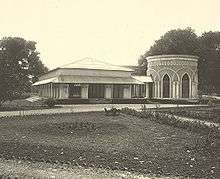Madhur Canteen
| Madhur Canteen | |
|---|---|
| মধুর রেস্তোরা | |
 | |
| General information | |
| Location |
|
| Town or city | Dhaka |
| Country | Bangladesh |
| Coordinates | 23°43′54″N 90°23′33″E / 23.731547°N 90.392497°E |
| Groundbreaking | 1873 |
| Renovation cost | free |
| Client |
students Caretaker = Arun Kumar Dey |
| Landlord | DU |

Madhur Canteen (Madhu’s canteen) is a familiar name in the history of the Dhaka University as well as in the national politics of Bangladesh because of its association with various political movements which originated from the Dhaka University. The canteen's current location holds important architectural and heritage value.
Madhusudan Dey (Modhu), the canteen's founder, is an equally important figure in the socio-political history of the region. He was killed on 25 March 1971 at the beginning of the Bangladesh Liberation War. As part of Operation Searchlight, the Pakistan Army attacked the Dhaka University. Madhusudan Dey was taken to Jagannath Hall by the Pakistani armed forces where he was executed along with many University students. After the Liberation War, Arun Kumar Dey assumed the responsibility of running the canteen. Years after Modhu’s death, the canteen remains a significant landmark and also a place for gathering in the community.
History of the canteen

Origin
Madhur Canteen was started in 1921, when Madhusudan Dey (Modhu) came to Dhaka with his father, Aditya Chandra, at the age of 15. Aditya Chandra, with the permission of the university authorities, began selling food in the Dhaka University Campus which was, at the time, located in the present Dhaka Medical College building . The canteen was shifted later when the Arts Faculty of the University was shifted to a new building at Nilkhet.
Madhur canteen played a pivotal role in the Bangladesh Liberation Movement . It was the focal point for the start of various political movements in the country .The canteen played a significant part in the Language Movements of 1948 and 1952, the movement of fourth-class Dhaka University employees in 1949, the student’s revolt against the black laws (kala kanoon) of the university, and the 1969 mass uprising in East Pakistan . During these critical political moments, Madhur Canteen was a social epicenter frequented by student leaders and activists. The Pakistani army targeted Madhur Canteen on 25 March 1971, with the beginning of operation Searchlight.[1]
Massacre
Madhusudan Dey was killed on the 26th of March, 1971. The Pakistani military stormed his house and started firing in the early morning hours. Dey's wife, son and daughter-in-law were amongst those killed.Madhusudan Dey was injured in the firing, arrested and taken to the Jagannath Hall playground where he was killed alongside many students.[2]
Present location

Madhur Canteen was reconstructed after suffering severe damage during the liberation war.The canteen was relocated from its original location in the present-day Dhaka Medical college building to an old structure.The canteen's present location served as the Durbar Hall of the Dhaka Nawabs. Apart from being used as a venue for formal and informal meetings, it also served as a skating rink and ball room for enjoyment of the Nawabs. Construction of the building began in 1873 which continued over several years.[3] In 1906 a conference was held in the building, sponsored by Nawab Khwaja Salimullah,the Nawab of Dhaka that led to the formation of the All-India Muslim League.[2]
Toufiq Hosen Khan, a student of fine arts, engraved a statue of Madhusudan Dey in 1995, which remains in front of the Madhur Canteen to the present day. .[4]
References
| Wikimedia Commons has media related to Madhur Canteen DU. |
- ↑ Chowdhury, Promiti Prova. "Madhur Canteen- The adda crucible that forged history". dhakatribune.com. Dhaka Tribune. Retrieved 11 July 2015.
- 1 2 Yusuf, Ananta. "The Legacy of Madhu's Canteen". archive.thedailystar.net. The Daily Star. Retrieved 12 July 2015.
- ↑ Alamgir, Mohammad (2012). "Shahbag". In Islam, Sirajul; Jamal, Ahmed A. Banglapedia: National Encyclopedia of Bangladesh (Second ed.). Asiatic Society of Bangladesh.
- ↑ "Madhur canteen brief".
Further reading
- Muntassir Mamoon 2003 Dhaka Shomogro, ISBN 978-984-412-369-4
- Mahbubur Rahman 2011, City of an architect, ISBN 978-984-33-2451-1
- Gopal Das 2007, Manidipto Campus